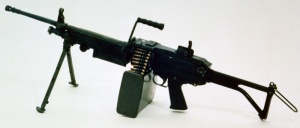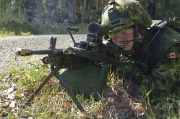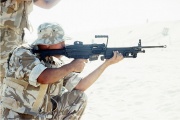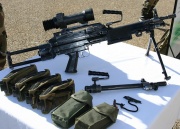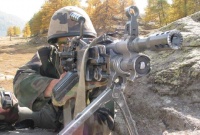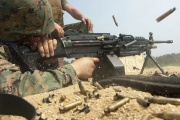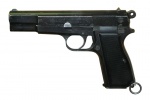FN Minimi
| |||||||||||||||||||||||||||||||||||||||||||||||||||||||||
The Minimi (short for French: Mini Mitrailleuse; “mini machine gun”) is a Belgian 5.56 mm light machine gun developed by Fabrique Nationale (FN) in Herstal by Ernest Vervier. First introduced in 1974, it has entered service with the armed forces of several countries, among them: Australia, Belgium, Canada, France, Greece, Italy, Indonesia, Malaysia, New Zealand, Thailand, Sweden, the United Kingdom and the United States (as the M249 SAW). The weapon is currently manufactured at the FN facility in Herstal as well as being license-built in Australia, Greece and the USA (by FN Manufacturing LLC). The Minimi is configured in several variants, the standard model (as a platoon or squad support weapon), the Para version (for use with armored vehicle crews, helicopter pilots and parachute infantry) and the vehicle model (as secondary armament for fighting vehicles).
Contents |
[edit] Design details
The Minimi is an air-cooled automatic weapon, capable of fully automatic fire only, that uses a gas piston operating system with a short-stroke piston. The barrel is locked with a rotary bolt, equipped with two massive locking lugs, forced into battery by camming guides in the bolt carrier. Upon firing, the piston is forced to the rear by expanding propellant gases bled through a port in the barrel near the muzzle end. The piston rod acts against the bolt carrier, which begins its rearward motion guided on two rails welded to the receiver walls, while the bolt itself remains locked. This sequence provides a slight delay that ensures chamber pressure has dropped to a safe level by the time a cam in the bolt carrier rotates and unlocks the bolt, increasing extraction reliability as the empty cartridge casing has had the time to cool down and contract, exerting less friction against the chamber walls. The Minimi fires from an open bolt, which eliminates the danger of a round cooking off after extended periods of continuous fire, since a cartridge is only momentarily introduced into the chamber prior to ignition, and the movement of the bolt and bolt carrier forces air through the chamber and barrel after each shot, ventilating the barrel and slowing heating. Gas escaping the gas cylinder is directed upward, avoiding kicking up dust and debris that would reveal the shooter's position. The Minimi has a manually adjustable gas valve with two positions, normal and adverse. The adverse setting increases the cyclic rate of fire from 700-850 rounds/min to 950-1150 rounds/min and is used only in extreme environmental conditions or when heavy fouling is present in the weapon’s gas tube. The spring extractor is located inside the bolt, while the tilting lever ejector is contained inside the receiver housing. Spent casings are removed through a port located at the forward, bottom right side of the receiver, protected with a dust cover. The Minimi is striker-fired and the bolt carrier functions as the striking mechanism.
The weapon is fed from the left-hand side by disintegrating-link M27 ammunition belts (a miniaturized version of the 7.62 mm M13 belt), from either an unsupported loose belt, enclosed in an ammunition box with a 200-round capacity (made of a synthetic polymer) attached to the base of the receiver, or from detachable STANAG magazines, used in other NATO 5.56 mm assault rifles such as the M16 and FNC. Magazine feeding is used only as an auxiliary measure, when belt-linked ammunition has been exhausted. The ammunition belt is introduced into the feed tray, magazines are seated inside the magazine port at a 45° angle, located under the feed tray port. When a belt is placed in the feed tray it covers the magazine port. Likewise, a magazine inserted into the magazine well will prevent the simultaneous insertion of a belt. The magazine port, when not in use, is closed with an L-shaped hinged flap equipped with a tooth, which engages a corresponding opening in the magazine and serves as a magazine release. This innovative feature was developed by FN's Maurice V. Bourlet (US patent 4112817) and allows the Minimi to pass instantaneously from belt feed to magazine feed without any modification.[2] The pawl-type feeding mechanism is modeled on the system used in the MAG general purpose machine gun, which borrows from the World War II-era MG42. The belt is moved in two stages during both the forward and rearward movement of the reciprocating bolt carrier, which provides for a smooth and continuous feeding cycle. The feeding mechanism top cover features a device that indicates the presence of a cartridge in the feed path.
The Minimi has a push-button type manual safety installed in the trigger housing, above the pistol grip. In the “weapon safe” position, it disables the sear mechanism; pushing the button to the right side exposes a red-colored rim on the left side of the firearm and indicates the weapon is ready to fire. The black polymer pistol grip was initially copied directly from the FAL and FNC rifles, currently a modified grip with lateral grooves is used, installed at a smaller angle to the receiver.
The barrels used in the Minimi have an increased heat capacity for sustained fire, feature a chrome-lined rifled bore (6 right-hand grooves) and are manufactured in two versions: with a 178 mm (1:7 in) twist rate used to stabilize the heavier Belgian 5.56x45mm SS109 projectile, or a 305 mm (1:12 in) twist for use with American M193 ammunition. The barrels have a quick-change capability; a lever is provided on the left side of the weapon that releases the barrel from its trunnion. A carrying handle is also fixed to the barrel and assists in the barrel change process. A trained soldier will be able to perform a barrel change and ready the weapon for aimed fire in only 6-7 seconds. Early versions of the Minimi had a flash suppressor with side ports as seen on the FNC, CAL and FAL rifles; new production guns have a shorter, cone-shaped slotted flash suppressor.
The standard light machine gun version has a 465 mm (18.3 in) barrel and a skeletonized aluminum stock with a folding wire shoulder strap. The shortened Para model has a 349 mm (13.7 in) barrel and a collapsible metal stock, while the vehicle-mounted model has a 465 mm (18.3 in) barrel but does not have a stock or iron sights. All models can alternatively be fitted with a fixed synthetic stock, the same used on the M249, which contains a hydraulic buffer that contributes to stabilizing the rate of fire and reducing recoil forces.[3]
The Minimi features a welded receiver made from stamped steel. Both the standard and Para variants are equipped with a fixed, folding bipod mounted to the gas tube and stowed under the handguard. The bipod can be adjusted in height and each leg has three height settings. The bipod also offers a 15° range of rotation to either side. With the bipod fully extended, the bore axis is elevated to a height of 465 mm (18.3 in). The Minimi can also be fired from the Belgian FN360° tripod or the American M122 mount using an M60 pintle. The vehicle-mounted Minimi is fitted with an electrically-powered trigger that enables it to be fired remotely from within an armored fighting vehicle.
Both the standard and Para models come with a rear sight, adjustable for windage and elevation, that provides a peep aperture for ranges from 300 to 1000 m in 100 m increments. The hooded front sight is installed in a post on the gas block and is also adjustable for elevation and windage. Early models of the Minimi had the rear sight mounted forward of the feed cover and the front post secured to the barrel, closer to the muzzle end. An adapter can also be used that allows the use of standard NATO night and day sights. Standard equipment supplied with the Minimi consists of three ammunition boxes with a 200-round capacity each, a cleaning kit stored inside the forearm, lubricant bottle, sling and blank-firing adaptor.
[edit] Variants
The M249 version of the Minimi was adopted by the US military in 1982, and since 1984, production is carried out entirely in the US by a local subsidiary - FN Manufacturing LLC in South Carolina.
As part of the US military's M249 PIP (Product Improvement Program), the M249 was updated with: a new synthetic stock and modified buffer assembly; a single-position gas regulator; a “birdcage” type flash hider/compensator from the M16A2; a polymer barrel heat guard; and a folding carry handle. As a result, the weapon’s weight increased to 7.47 kg (16.5 lb). Many of the PIP upgrades were later incorporated by FN for the Minimi.
A lightweight variant of the Para with a Picatinny top cover rail adapter is known as the Minimi SPW (Special Purpose Weapon). It had the magazine feed port removed to further reduce weight, and a railed MIL-STD-1913 handguard was used that enables the use of standard tactical accessories.
Another variant of the SPW requested by the US Special Operations Forces is the Mk 46 Mod 0 that incorporates a lightweight fluted barrel but lacks the magazine feed system, vehicle mounting lugs and carry handle. A railed forearm ensures modularity and mission-adaptability permitting the use of flashlights, vertical grips, and infrared laser designators. An improved variant known as the Mk 46 Mod 1 with an improved forward rail and lightweight titanium bipod has been adopted by the United States Navy.
The Minimi prototype was originally designed in 7.62x51mm NATO, and later redesigned around the 5.56 mm cartridge. When the USSOCOM issued the requirements for the Mk 48 Mod 0, the original plans for the Minimi were retrieved and used to develop this new model. As a result of favorable reviews of the Mk 48 Mod 0 and increasing demand for a more powerful variant of the Minimi, FN Herstal introduced the Minimi 7.62 available in several different configurations. Apart from the different caliber, the Minimi 7.62 incorporates a non-adjustable, self-regulating gas system and a hydraulic recoil buffer in the buttstock assembly. The Minimi 7.62 also has a different sight setup calibrated for the larger cartridge. The rear sight is adjustable from 100 to 1,000 m by 100 m increments. The sight can also be corrected for windage. A variant of the Minimi 7.62 equipped with a railed Picatinny handguard is the Minimi 7.62 TR.
Copies of the Minimi have been produced in China, called the XY 5.56 x 45, produced in 5.56x45mm NATO.[4] It is meant for export.[4]
[edit] Users
[edit] NATO
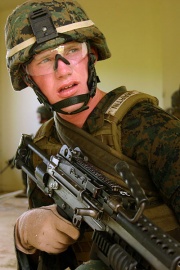
- Belgium: Belgian Land Component and Belgian Air Component regular troops use the standard Minimi (M1). Airborne troops use the Para model (M3).
- Canada: The Canadian Forces C9 is a standard factory Minimi with a steel tubular stock. The C9A1 comes fitted with a Picatinny rail on the feed cover and a 3.4x ELCAN C79 telescopic sight.[5] The C9A2 mid-life upgrade introduced a shorter barrel, green furniture, cloth ammo boxes (replacing the plastic containers), a C8-style collapsible stock, folding vertical foregrip and a laser aiming module (LAM).[6] Two C9s are carried by each infantry section. All are made by Diemaco[7].
- France: Widely used by the French Army. Replaced the AAT-F1 GPMG.[8]
- Greece: Manufactured under license by EAS, used by the Hellenic Army and special forces.[9] First 10 examples delivered in 1999.
- Italy: The Minimi is made under license by Beretta, which has a partnership with FN, and is employed by the Italian Armed Forces, replacing the MG42/59 (variant of the WWII MG42, which still sees widespread mounted use) in the squad automatic weapon role. The Minimi is being widely employed by Italian forces in all the most recent and current international theaters of operation.[10]
- Latvia: Standard light machine gun in Latvian inventory.[11]
- Netherlands: The Royal Netherlands Army has brought in the Para version of the Minimi to replace the FN MAG in some infantry roles. The MAG is still being used as a general purpose machine gun, support fire weapon and as a vehicle-mounted weapon.[12]
- Norway: Used by Coastal Rangers and Army Ranger Command.
- Poland: Used by the Polish Special Forces unit GROM. GROM also uses the 7.62 mm Minimi 7.62 machine gun.
- Slovenia: Minimi Para used by the Military of Slovenia.[13]
- United Kingdom: Uses both the standard and Para variants, known as the L108A1 and the L110A1 respectively.[14] The British Army equips each four-man fireteam (2 per section) with the current variant of the Minimi Para. This weapon augments the L86 LSW in the British Army as a light section support weapon. The LMG is often fitted with a 4x SUSAT (Sight Unit Small Arms Trilux) optical sight. It is also used by the Royal Navy, Royal Marines Commandos and the RAF Regiment.
- United States: Officially adopted on February 1st 1982 as the M249 Squad Automatic Weapon. However, official distribution was delayed until the late 1980s. In the United States Army and Marine Corps, the SAW is usually carried at the fireteam level; one member of a three to five-man team carries this weapon. The SAW is also standard issue for a four to five-man amphibious reconnaissance team.
[edit] Non-NATO
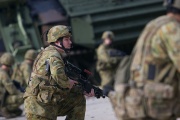
- Argentina: The Argentine Marine Corps uses the M249 SAW in all of its combat arms (e.g. infantry, artillery, reconnaissance) units. These firearms were acquired as part of the Marine Corps' modernization program of the mid to late 1990s.
- Australia: Designated F89 in Australian service. The Australian Army, the Royal Australian Navy and the Royal Australian Air Force use a locally built (ADI) version of the Minimi since 1991. It is essentially the same as the standard model, but fitted with the same 1.5x magnification optical sight as used on the F88 rifle. It also has a longer flash suppressor (identical to the one used on the FN MAG), as well as a hydraulic buffer to maintain a consistent rate of fire whether in the normal or adverse gas settings (initial shipments did not have the hydraulic buffer installed, leading to premature fatigue of the firing mechanism when on the extreme gas setting due to the increase in the rate of fire from 700 rounds/min to 1000 rounds/min) and a locally-developed 200-round collapsible bag magazine. During 1999 the F89 was modified, the optical sight mounting on the feed cover being replaced by a MIL-STD-1913 Picatinny rail mounting that can accommodate either the F88 optical sight or and the ELCAN Wildcat enhanced optical sight. The rail can also accommodate the Project Ninox night weapon sight. The F89 has no heat shield and the carrying handle is fixed, not folding. Each F89 comes with two live barrels and one blank-firing barrel. The gunner will normally carry the spare barrel in the field. Two F89s are carried in each nine-man rifle section. Small numbers of the Minimi Para are used by Australian paratroopers and special forces, these weapons do not have the hydraulic buffer installed.
- Brazil: The Brazilian Marines adopted the Minimi as their platoon support weapon in the mid 1990s.
- Chile: The Chilean Army.
- East Timor: Timor Leste Defence Force[15]
- Indonesia: One Minimi is issued to each squad of the Indonesian Army and the Indonesian Marine Corps. The Kopassus unit also employs the Minimi.
- Ireland: The Irish Army Rangers currently use the Minimi Para.
- Israel: Used by the Israeli Defence Forces (IDF). Limited numbers of weapons were purchased in the early 1990s and saw combat in south Lebanon. Replaced in 1995 with the indigenous Negev light machine gun.
- Japan: Partially replaced the NTK-62 with the Japanese Ground Self-Defense Forces. It is manufactured under license by Sumitomo Heavy Industries.[16]
- Kuwait
- Lebanon: Used by the Lebanese Navy SEALs Regiment of the Lebanese Armed Forces.
- Malaysia: The Malaysian Army replaced the HK11A1 machine gun with the Minimi. Also used by police special force units.
- Mexico: The Mexican Army and Navy use the M249 and Minimi machine guns, as well as the Grupo Aeromóvil de Fuerzas Especiales and Fuerzas Especiales.
- Morocco
- Nepal: The Nepalese Army uses 5,500 Minimi machine guns. Delivery was endorsed on July 11, 2002 by the Belgian government.
- New Zealand: The New Zealand Defence Force (Royal New Zealand Navy, Royal New Zealand Air Force and New Zealand Army) all use the Minimi under the designation C9 Minimi. This gun has been used as the army's Light Support Weapon (LSW) since 1988.[17]
- Peru
- Philippines: In use by the Armed Forces of the Philippines (AFP). Purchased the M249 variant.
- Saudi Arabia: In use by the Saudi Arabian National Guard.
- Sri Lanka: The first country in the world to adopt the Minimi as a squad support weapon. Supplied directly from Belgium by FN Herstal.
- Sweden: Known as the Ksp 90 (Kulspruta 90). Para model designated Ksp 90B.[18][19]
- Switzerland: Known as the LMg 05 and has partially replaced the MG51 which remains in service.
- Taiwan: The Republic of China Army field the Minimi under license as the Combined Service Forces (CSF) Type 75, formerly done under Hsing-Hua Arsenal.
- Thailand
- Venezuela
- United Arab Emirates
[edit] Resources
- Manuals and diagrams for the M249 variant of the Minimi can be found here.

This article or section is missing resources, such as diagrams or manual links, and could use more input to fill in the missing bits. You (yes, you!) can help Gunsopedia provide more comprehensive information to our users by using your own knowledge to add to it.
[edit] Notes
- ↑ MINIMI 7.62 Standard Sliding Butt
- ↑ http://www.google.com/patents?id=zo06AAAAEBAJ
- ↑ "The MINIMI 5.56 can be fitted with a hydraulic buffer for stabilized rate of fire and reduced recoil forces. The design of the buttstock contributes to easy, comfortable and accurate firing." - FNHerstal.com
- ↑ 4.0 4.1 Popenker, Maxim & Williams, Anthony G., page 41.
- ↑ The Canadian Army - Equipment
- ↑ Canadian Forces - Small Arms - Machineguns - Index - CASR DND 101 - Visual Guide - Canadian American Strategic Review - GPMG - General Purpose Machine-Guns - Light Machine-Gun...
- ↑ Multiplying the Sources. Retrieved on October 5, 2008.
- ↑ Terre - MINIMI
- ↑ Hellenic Defense Systems
- ↑ http://www.esercito.difesa.it/root/equipaggiamenti/armi_legg.asp#individuali
- ↑ http://www.mod.gov.lv/upload/nbsfakti.anglu.gala.pdf
- ↑ Koninklijke Landmacht - MINIMI
- ↑ http://www.slovenskavojska.si/poklicna/oborozitev/pm_minimi_para.htm
- ↑ http://www.army.mod.uk/equipment/support-weapons/1462.aspx
- ↑ Jane's Sentinel Security Assessment - Southeast Asia. Issue 20 – 2007. Coulsdon: Jane's Information Group. pp. 146 and 152.
- ↑ Exhibition of Equipments. Retrieved on July 29, 2008.
- ↑ http://www.army.mil.nz/our-army/equipment/weapons/machine-guns.htm New Zealand Army official site
- ↑ Lätt kulspruta 90. Retrieved on October 6, 2008.
- ↑ General Purpose Machine Guns of Sweden. Retrieved on October 9, 2008.
[edit] References
- Popenker, Maxim & Williams, Anthony G. (2008). Machine Gun. The Development of the Machine Gun from the Nineteenth Century to the Present Day. London: Crowood Press. ISBN 978-1847970305.
[edit] External links
- FN Herstal official page (5.56 mm Minimi standard)
- FN Herstal official page (Minimi 7.62)
- Modern Firearms
- REMTEK
- Nazarian`s Gun`s Recognition Guide
| This article is part of a series on FN Herstal firearms | ||
|---|---|---|
| Handguns | Barracuda · Five-seven · FNP series/FNX series · Forty-Nine · Hi-Power · HP-DA · M1900 · M1903 · M1905 · M1910 | |
| Rifles | Semi-auto & select — C1 · CAL · F2000 / FS2000 · FAL · FNAR · FNC · Model 1949 · PS90 · SCAR-L/SCAR-H Bolt-action — Model 1950 · Model 30-11 · PBR · SPR · TSR | |
| Shotguns | SLP · TPS | |
| Submachine guns | P90 | |
| Machine guns | BRG-15 · M2 · MAG· Minimi · Mle 1930 | |
| Other stuff | 5.56x45mm SS109 · 5.7x28mm · EGLM · FN 303 | |
